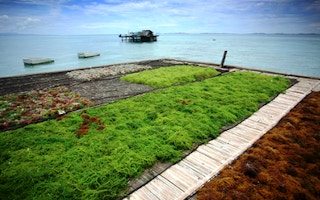It took fisherman Angelino Rebintinola at least two trips of cyanide fishing in the South China Sea to realize that what he had earned from this illegal activity was not worth the destruction it brought to the marine ecosystem.
“I joined illegal fishing activities back in the 1980s,” Rebintinola, 56, of Barangay (village) Tagburos in Puerto Princesa City, said in an interview with journalists in April.
He said he was with a group of Chinese fishermen who were into cyanide fishing in the South China Sea. “But after two or three trips, I realized it’s not good for the environment,” he said.
In 2009, through a project that sought to remedy the depletion and destruction of marine resources in the country, Rebintinola discovered a more earth-friendly way to earn a living—cultivating seaweeds.
At present, Rebintinola is the project manager of the Pandan Island Multi-Purpose Cooperative (PIMPC), one of the top producers of seaweed in Puerto Princesa.
Income diversification
Seaweed farming is one of the “income diversification” components of the Fisheries Resource Management Project (FRMP) in the Philippines funded in part by Asian Development Bank (ADB), with the Department of Agriculture and the Bureau of Fisheries and Aquatic Resources serving as executing and implementing agencies.
The project aims to lessen the coastal communities’ reliance on fishing by promoting alternative—and more profitable—livelihoods. Aside from promoting seaweed farming, the FRMP has established protected areas such as fish sanctuaries, which checked coral destruction and enhanced marine life.
It also helps communities to venture into other small businesses, such as crab fattening, fish-pen culture and piggeries.
Members of the PIMPC said cultivating seaweed was more profitable than fishing because of the big demand for this marine resource. Seaweed, a type of algae, is used in manufacturing a variety of food and nonfood products, including ice cream, noodles and vitamin capsules.
Rebintinola said a kilo of dried seaweeds could earn P46 for seaweed farmers and P2 for the cooperative. One kilo of dried seaweeds is produced from 7 kilos of mature fresh seaweeds or 10 kilos of young fresh seaweeds.
Good harvest
According to Delia Martinez of the fisheries sector of the city agriculturist office, farmers can generate as much as 5 tons of dried seaweed in one planting activity. “That’s already considered a good harvest,” she said.
In February, the government’s Philippine Information Agency reported Palawan was the top seaweed-producing province in the country with 477,185 metric tons in 2011, citing records from the Bureau of Agriculture Statistics.
Mario Mulato, 59, PIMPC chairman, said fishing was more difficult than growing seaweed. “When you fish, you’re always tired because there’s less time to sleep. You work from night until morning,” he said.
Rebintinola agreed, saying that in seaweed farming, “you manage your own time.”
To cultivate seaweed, seedlings are tied with straw along a nylon rope or the “main line,” which is about 15 dipa or arm spreads, Rebintinola said. The main line is set in the middle of the sea and anchored by ropes to the sea floor. Sealed empty plastic bottles are tied to the rope as floaters to buoy the main line.
If the weather is good, the seaweeds are harvested after 45 days, then dried for four days, he explained.
“All you need to do is maintenance work,” Rebintinola said, which meant cleaning the seaweeds twice a week.
Good for environment
Both Rebintinola and Mulato expressed hope that more people would consider seaweed farming as their main livelihood because of its financial and environmental benefits. “We want to encourage more people to try seaweed farming,” Mulato said.
Rebintinola emphasized the importance of protecting the environment. He said illegal-fishing practices, like the use of cyanide, has a devastating impact to the marine ecosystem, so people must do their part to protect it.
“We must educate people, especially our children, and make them aware [of these environmental issues],” Rebintinola said. “If we protect the marine environment, we can help enrich our marine resources,” he added.
According to the ADB, under the FRMP, a total of 56 barangays in Puerto Princesa have benefited from the livelihood projects.
Fish sanctuaries
A total of 370 hectares of the city’s marine area has been declared fish sanctuaries. “The first fish sanctuaries were in Barangays Binduyan and Manalo and were funded by ADB. These became our models when establishing other fish sanctuaries,” Martinez said.
The two sanctuaries, the 74-hectare Manalo Fish Sanctuary and the 40-ha Binduyan Sabang Reef Fish Sanctuary, were established in 2000 and 2002, according to the Coastal Conservation Education Foundation website.
“Through city ordinances, we have established 15 fish sanctuaries, and have proposed seven more,” Martinez said.
Increased tourism activity in Palawan has also helped in the city’s ongoing marine protection activities.
According to Martinez, the Pambato Fish Sanctuary on Pambato Reef has not only increased fish stock but has also become an income-generating project by becoming a snorkeling destination for tourists who want to see different kinds of marine life.
“It’s the first fish sanctuary established as an ecotourism area,” she said.










